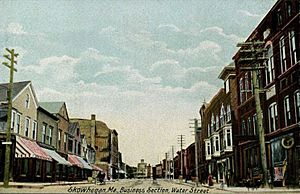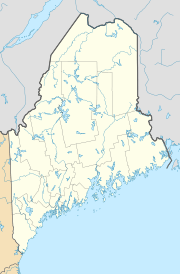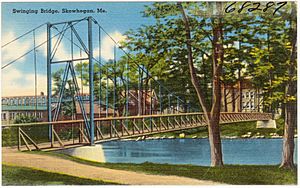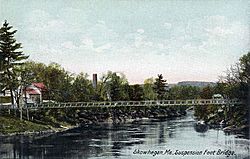Skowhegan, Maine facts for kids
Quick facts for kids
Skowhegan, Maine
|
||
|---|---|---|

Water Street in 1906
|
||
|
||
| Motto(s):
A Place to Watch
|
||
| Country | United States | |
| State | Maine | |
| County | Somerset | |
| Settled | 1771 | |
| Incorporated | February 5, 1823 | |
| Area | ||
| • Total | 60.47 sq mi (156.62 km2) | |
| • Land | 58.85 sq mi (152.42 km2) | |
| • Water | 1.62 sq mi (4.20 km2) | |
| Elevation | 223 ft (68 m) | |
| Population
(2020)
|
||
| • Total | 8,620 | |
| • Density | 163/sq mi (63.1/km2) | |
| Time zone | UTC-5 (Eastern (EST)) | |
| • Summer (DST) | UTC-4 (EDT) | |
| ZIP code |
04976
|
|
| Area code | 207 | |
| FIPS code | 23-68910 | |
| GNIS ID | 0579029 | |
Skowhegan (/skaʊˈhiːɡən/) is a town in Maine, United States. It is the main town of Somerset County. In 2020, about 8,620 people lived there.
Every August, Skowhegan holds its yearly State Fair. This fair is the oldest one in the United States that has happened every year without stopping. The name Skowhegan comes from the Abenaki people. It means "watching place [for fish]". The Abenaki were the first people to live in this area.
Contents
History of Skowhegan
First People in the Area
For thousands of years, the Kinipekw tribe lived in this part of Maine. They were also known as the Norridgewock tribe of the Abenaki people. Their main village was in what is now Madison.
The Abenaki grew corn, beans, and squash for food. They also hunted, fished, and gathered wild plants. The Skowhegan Falls on the Kennebec River were very important to them. Here, they could easily catch many fish like salmon.
The Abenaki used this area as a key stop during their yearly travels. They would move from northern hunting grounds in winter to the coast in summer. They dried fish on an island and planted crops to harvest later. Because of the great fishing, they called the area Skowhegan, meaning "watching place [for fish]".
The Norridgewock Conflict
In 1722, a war started between the Massachusetts government and the Abenaki. On August 22, 1724, soldiers from Massachusetts attacked the main Abenaki village. This event is known as the Battle of Norridgewock.
The attack was part of a larger conflict called Dummer's War. The English wanted to expand their settlements into Abenaki lands. During the attack, many Abenaki people were killed. Their farms were burned, and survivors had to leave their village. Most of the Abenaki moved north to a village in Quebec.
Early European Settlers
The first European families settled in the Skowhegan area in 1771. They were pioneers from southern Massachusetts. They traveled up the Kennebec River to find new land.
The first group included the Heywood and Weston families. They built a cabin on an island in the river. They planted crops and cared for their animals. Two young men, Eli Weston and Isaac Smith, spent the first winter alone on the island. More families joined them in 1772.
Dr. Nathaniel Whitaker was an important early settler. He was the first minister, doctor, and even a lawyer in the area. In 1811, General Josiah Locke, a hero from the Revolutionary War, opened an inn. He also served as the postmaster for many years.
Benedict Arnold's Journey
On September 29, 1775, Colonel Benedict Arnold and his soldiers passed through the village. They were on their way to the Battle of Quebec. Joseph Weston, one of the first settlers, sadly died during this journey.
Founding the Town
The area officially became a town on February 5, 1823. It was first named Milburn. However, people preferred the old name, Skowhegan, so it was renamed in 1836.
Over the years, Skowhegan grew by adding parts of nearby towns. In 1861, the town of Bloomfield, across the river, became part of Skowhegan. In 1871, Skowhegan became the county seat, which means it became the main town for government in the county.
Local Businesses and Factories
Early farms in Skowhegan grew hay, potatoes, wheat, and raised sheep for wool. The Skowhegan Fair started in 1818, and the first fair was held in 1819. The railroad reached the town in 1856, helping businesses grow.
The Skowhegan Falls provided strong water power for factories. Because of this, Skowhegan became a "mill town." Many factories were built on Skowhegan Island. These included paper mills, sawmills, and factories making things like shoes and woolen cloth.
In 1907, textile workers in Skowhegan went on strike. They wanted better wages so they could live comfortably. The strike was successful, and their demands were met. Today, companies like Sappi Fine Paper and New Balance Athletic Shoe Company have factories in Skowhegan.
In 2003, Skowhegan was a filming location for the HBO movie Empire Falls. This movie was based on a book by Maine author Richard Russo.
Skowhegan also hosts the yearly KNEADING Conference. This event, started in 2007, teaches about local wheat, milling, baking, and building special ovens.
Geography
Skowhegan covers about 60.47 square miles (156.62 square kilometers). Most of this area is land, with a small part being water. The town is drained by the Wesserunsett Stream and the Kennebec River. Loomis Hill is the highest point in town, standing about 870 feet (265 meters) above sea level.
Population Information
| Historical population | |||
|---|---|---|---|
| Census | Pop. | %± | |
| 1830 | 1,006 | — | |
| 1840 | 1,584 | 57.5% | |
| 1850 | 1,756 | 10.9% | |
| 1860 | 2,266 | 29.0% | |
| 1870 | 3,893 | 71.8% | |
| 1880 | 3,860 | −0.8% | |
| 1890 | 5,068 | 31.3% | |
| 1900 | 5,180 | 2.2% | |
| 1910 | 5,341 | 3.1% | |
| 1920 | 5,981 | 12.0% | |
| 1930 | 6,433 | 7.6% | |
| 1940 | 7,159 | 11.3% | |
| 1950 | 7,422 | 3.7% | |
| 1960 | 7,661 | 3.2% | |
| 1970 | 7,601 | −0.8% | |
| 1980 | 8,098 | 6.5% | |
| 1990 | 8,725 | 7.7% | |
| 2000 | 8,824 | 1.1% | |
| 2010 | 8,589 | −2.7% | |
| 2020 | 8,620 | 0.4% | |
| U.S. Decennial Census | |||
Population in 2010
In 2010, there were 8,589 people living in Skowhegan. Most residents (96.9%) were White. About 28.5% of households had children under 18. The average age in town was 42.2 years old.
Arts and Culture
Skowhegan Historic District
The Skowhegan Historic District has 38 important buildings. Most of these buildings were built between 1880 and 1910. This area includes the main shopping streets, like Water Street. The buildings show different styles from that time. Skowhegan is one of ten "Main Street" communities in Maine. This program helps improve downtown areas.
Bridges of Skowhegan
One special feature of Skowhegan is the Swinging Bridge. This is a footbridge that swings a little as you walk on it. It was first built in 1883 to connect Skowhegan Island to the south side of the Kennebec River. The bridge was built for a local farmer to make his walk shorter.
The first bridge lasted six years. It collapsed in 1888 because the cables rotted. A new bridge was built, but a flood washed it out in 1901. Another bridge was built higher, but it also washed out in a flood in 1936. The current Swinging Bridge was rebuilt after that flood and has been used ever since. It was updated in 2006.
There is also a railroad bridge that was changed into a footbridge across the Kennebec River. This bridge was damaged in the Maine Flood of 1987.
Skowhegan Indigenous Statue
On the north side of the town's parking lot, there is a tall statue. It is 62 feet (19 meters) high. The statue shows an Abenaki person. It was carved by Bernard Langlais and put up in 1969. It honors the Native American people of Maine. The statue's dedication says: "Dedicated to the Maine Indians, the first people to use these lands in peaceful ways."
Municipal Building and Opera House
Another important building is the Municipal Building and Opera House. It was designed in the Beaux-Arts style by architect John Calvin Stevens. It was built between 1907 and 1909.
The Island
"The Island" in the Kennebec River used to have the old high school. Now, it is home to a church, an old textile factory, the historic fire station, and a "power house" that works with the dam on the river.
Notable People
Many interesting people have come from Skowhegan:
- Abner Coburn, who was the 30th governor of Maine.
- Louise Helen Coburn, who started the Sigma Kappa sorority.
- Margaret Chase Smith, who was a US senator.
- Maynard Pennell, a Boeing executive who was the chief engineer for the 707 airplane.
- Daniel Dole, a missionary and educator in the Hawaiian Islands.
Images for kids
See also
 In Spanish: Skowhegan (Maine) para niños
In Spanish: Skowhegan (Maine) para niños









